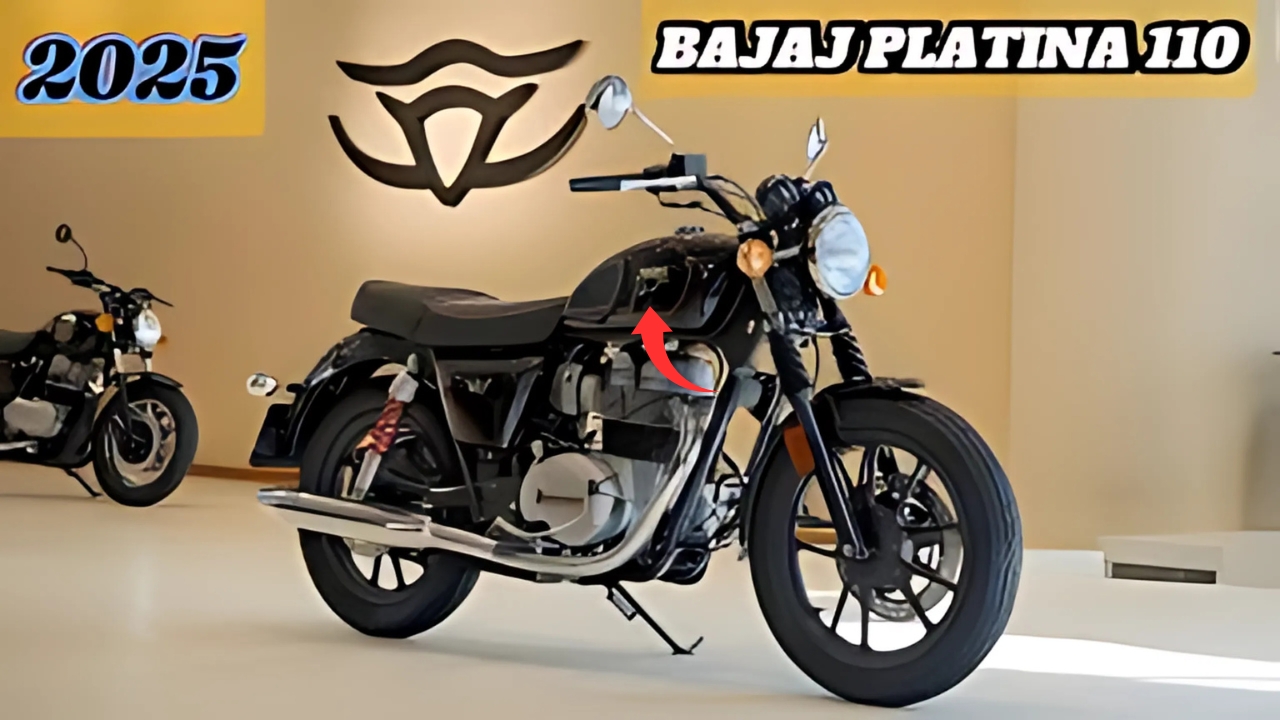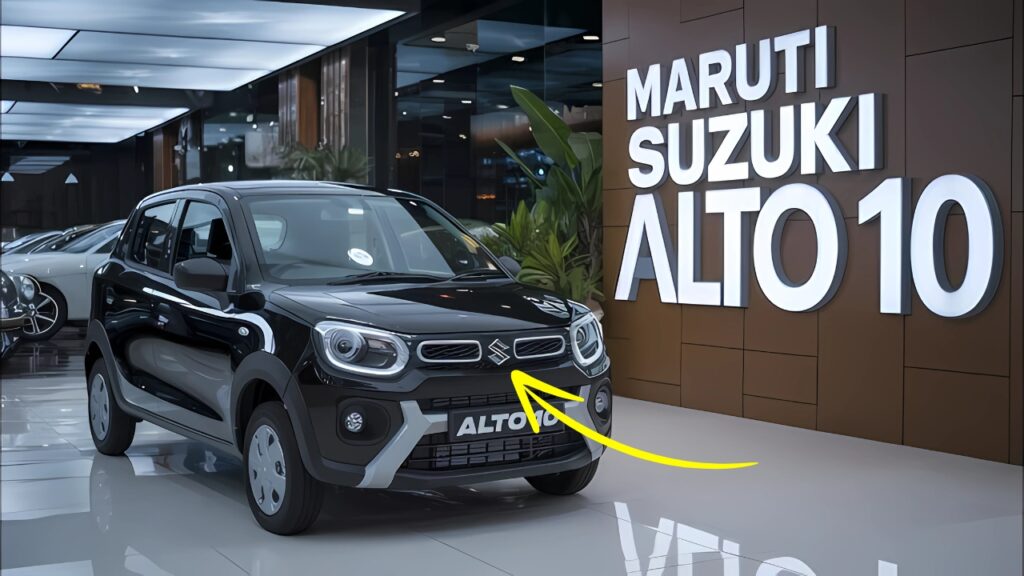Bajaj Platina 110: In a country where fuel prices continue to pinch household budgets, the humble motorcycle remains the backbone of personal transportation.
Among the sea of two-wheelers vying for attention, one particular model has quietly established itself as the undisputed champion of efficiency – the Bajaj Platina 110.
This unassuming commuter bike has become a household name not through flashy marketing campaigns or celebrity endorsements, but through its remarkable ability to stretch each drop of fuel further than competitors could imagine.
Bajaj Platina 110 Economy Champion: The 78 kmpl Milestone

The Bajaj Platina 110’s headline feature is undoubtedly its exceptional fuel efficiency. While the official ARAI-certified figure stands at 70 kmpl, real-world testing by thousands of owners across varied Indian riding conditions consistently reveals mileage figures between 75-80 kmpl, with many reporting a steady 78 kmpl during regular commuting.
“I’ve owned my Platina 110 for nearly two years now, covering about 18,000 kilometers,” shares Ramesh Kumar, a sales executive from Pune. “Initially, I was skeptical about the mileage claims, but I’ve consistently achieved 77-79 kilometers per liter during my daily office commute. That’s about 35% better than my previous motorcycle.”
This exceptional efficiency isn’t achieved through compromise but through thoughtful engineering. The motorcycle is powered by a refined 115.45cc DTS-i (Digital Twin Spark ignition) engine that utilizes two spark plugs per cylinder to ensure more complete combustion of the air-fuel mixture. This not only enhances mileage but also reduces emissions significantly.
The engine produces a modest but adequate 8.6 PS of power at 7,000 rpm and 9.81 Nm of torque at 5,000 rpm – figures that prioritize efficiency over outright performance.
The five-speed gearbox (in H-Gear variants) features a taller fifth gear specifically designed for highway cruising, allowing the engine to maintain lower rpms at steady speeds, further improving fuel efficiency during longer rides.
Affordability That Defies Inflation
In a market where two-wheeler prices have consistently climbed upward, the Bajaj Platina 110 remains refreshingly accessible. Priced at approximately ₹70,000 (ex-showroom) for the standard Drum variant, it offers exceptional value when considering the long-term savings from its fuel efficiency.
For budget-conscious buyers, this translates to an affordable monthly EMI of around ₹2,000 with standard financing options. The ownership mathematics become even more compelling when factoring in the reduced fuel expenditure.
For someone riding approximately 50 kilometers daily, the Platina 110 can potentially save ₹1,000-1,500 monthly in fuel costs compared to less efficient alternatives.
“I initially considered several options in the 110-125cc segment, including models from competitors,” explains Suresh Patel, a postal worker from Gujarat. “
Although some had more features or slightly more power, none could match the Platina’s total cost of ownership. The initial price plus three years of fuel and maintenance made it significantly cheaper than anything comparable.”
This affordability extends beyond the purchase price. The Platina 110 boasts remarkably low maintenance requirements, with service intervals typically costing under ₹1,000.
Parts availability is excellent across even remote parts of India, and the simple, proven mechanicals rarely develop major issues even after years of use in challenging conditions.
Comfort Beyond Its Price Class
While economy and affordability form the Platina 110’s core appeal, Bajaj hasn’t skimped on rider comfort – a crucial factor for daily commuters spending hours in the saddle.
The motorcycle features what Bajaj calls “ComforTec” technology, a package of design elements aimed at enhancing ride quality beyond what’s typical in this segment.
The longer, wider quilted seat provides excellent support for both rider and pillion, while the rubber footpads reduce vibration transmission. The suspension setup – telescopic front forks and spring-loaded hydraulic shock absorbers at the rear – is calibrated for Indian road conditions, soaking up potholes and rough patches with surprising composure.
“The seat comfort was actually what sold me on the Platina,” admits Lakshmi Devi, a nurse from Chennai who rides 30 kilometers daily to her hospital.
“I test rode several bikes, but the Platina was noticeably more comfortable over our rough roads. Even after my 12-hour shifts, the ride home doesn’t add to my fatigue.”
The motorcycle’s ergonomics are designed for an upright, natural riding position that reduces strain during longer journeys. The handlebar placement, seat height (807mm), and footpeg positioning accommodate riders of various heights without creating discomfort. For pillion riders, the wide grab rails and generous seating area make for a secure, comfortable experience.
Practical Features for Daily Use
Beyond the headline efficiency figures, the Platina 110 includes several thoughtful features that enhance its practicality as a daily commuter. The electric start ensures convenient operation in all conditions, while the maintenance-free battery reduces ownership hassles.
The instrument cluster, though basic, provides all essential information clearly, including a speedometer, odometer, and fuel gauge. The 11-liter fuel tank, larger than many competitors, combines with the exceptional mileage to deliver a theoretical range of over 800 kilometers between fill-ups – a significant convenience for riders in areas with limited fueling options.
Safety features include Bajaj’s Anti-Skid Braking (ASB) system, which activates both front and rear brakes when only the rear brake is applied, preventing wheel lock-up and improving stopping distances.
The tubeless tires reduce the risk of sudden deflation in case of punctures, while the better-equipped variants offer a front disc brake option for enhanced stopping power.
The LED daytime running lights improve visibility to other road users, while the halogen headlamp provides adequate illumination for night riding. The electrical system has proven reliable even in monsoon conditions, with good weather sealing protecting critical components.
Understated Design That Ages Well
While not making any bold styling statements, the Platina 110’s design strikes a balance between conservative approachability and modern touches.
The modest bikini fairing houses the headlamp and instrument cluster, while the fuel tank offers comfortable knee recesses for better rider positioning.
Available in several color options including Ebony Black with red or blue accents and Cocktail Wine Red with orange highlights, the motorcycle maintains a dignified appearance that ages well.
The graphics are tasteful rather than flashy, appealing to buyers who prefer understated reliability over attention-seeking design.
The alloy wheels not only reduce unsprung weight for better handling but also eliminate the maintenance requirements of spoke wheels. The exhaust features a chrome heat shield that adds a touch of premium feel, while the overall fit and finish demonstrate attention to detail despite the affordable price point.
The Ownership Experience
Perhaps the most telling endorsement of the Platina 110 comes from its devoted owner community. With thousands of examples on Indian roads, many with odometer readings exceeding 50,000 kilometers, the motorcycle has built a reputation for unfailing reliability and consistent performance.
“My father had a Platina 100 that ran for eight years without any major issues,” says Mohammed Rizwan, a small business owner from Hyderabad who recently purchased the 110cc model.
“When it was time for me to buy my own bike, I didn’t even consider other options. These bikes just keep running, year after year, with minimal attention.”
Bajaj’s extensive service network ensures that owners in even smaller towns and rural areas have access to authorized service centers with trained technicians and genuine parts.
The motorcycle’s mechanical simplicity means that most routine maintenance can be performed quickly and affordably, minimizing downtime for owners who depend on their vehicles for daily transportation.
Bajaj Platina 110 Verdict: Practical Perfection for the Masses
In a market often distracted by excessive features and specifications, the Bajaj Platina 110 stands as a reminder that the fundamentals still matter most to the average Indian two-wheeler buyer.
Its combination of exceptional efficiency, affordable pricing, comfortable ride, and proven reliability addresses the core needs of commuters without unnecessary frills.
For families watching every rupee, students on tight budgets, or working professionals maximizing their transportation value, the Platina 110 represents practical perfection – a tool that reliably performs its intended function while minimizing the financial burden of mobility.
In a world increasingly focused on sustainable transportation, this unassuming motorcycle also deserves recognition for its environmental credentials.
By extracting maximum distance from minimum fuel, it reduces both resource consumption and emissions per kilometer traveled – a form of everyday environmental responsibility accessible to millions of riders.
The Bajaj Platina 110 may never inspire passionate enthusiasm among motorcycle enthusiasts, but its rational excellence has earned something perhaps more valuable – the genuine appreciation of everyday riders who depend on their vehicles for life’s daily journeys.
FAQ: Bajaj Platina 110
Q: How does the Platina 110 achieve such impressive mileage figures?
A: The exceptional efficiency comes from multiple engineering choices. The DTS-i (Digital Twin Spark ignition) technology uses two spark plugs to ensure more complete fuel combustion.
The engine is tuned specifically for efficiency rather than outright performance, with optimized gearing ratios that keep the engine in its efficiency sweet spot.
The relatively light weight (119 kg) reduces the energy needed for acceleration, while the smooth aerodynamics minimize drag at cruising speeds.
Regular maintenance, proper tire inflation, and smooth riding techniques can help owners achieve or even exceed the claimed efficiency figures.
Q: What’s the difference between the regular Platina 110 and the H-Gear variant?
A: The primary difference is the transmission – the standard Platina 110 features a 4-speed gearbox, while the H-Gear (Highway Gear) variant comes with a 5-speed transmission.
The fifth gear in the H-Gear model is essentially an overdrive gear that allows the engine to run at lower RPMs during highway cruising, improving both efficiency and reducing engine wear during sustained high-speed running.
The H-Gear variant also typically includes a gear position indicator in the instrument cluster and may feature slightly different graphics or color options. Both share the same engine, chassis, and most other components.
Q: How does the maintenance cost of the Platina 110 compare to other motorcycles in its segment?
A: The Platina 110 has among the lowest maintenance costs in its category. Routine service typically costs between ₹700-900, with major services around ₹1,500-2,000.
The simple air-cooled engine design means fewer complicated components that could fail, while the proven technology has been refined over many years of production.
Parts are affordable and widely available across India.
Many owners report annual maintenance costs (excluding consumables like tires) of under ₹3,000 with normal usage patterns. The robust construction also means fewer unexpected repairs compared to some competitors with more delicate components.
Q: Is the Platina 110 suitable for taller riders?
A: The Platina 110 accommodates riders across a wide height range surprisingly well. With a seat height of 807mm and a relatively neutral riding position, riders between 5’4″ and 6’0″ typically find it comfortable. The handlebar position can be slightly adjusted during service to better suit individual preferences.
Very tall riders (above 6’2″) might find the ergonomics slightly cramped during longer journeys but still manageable for daily commuting.
The seat-to-footpeg distance provides adequate leg room for most Indian riders, while the wide seat allows for some position adjustment during longer rides.





